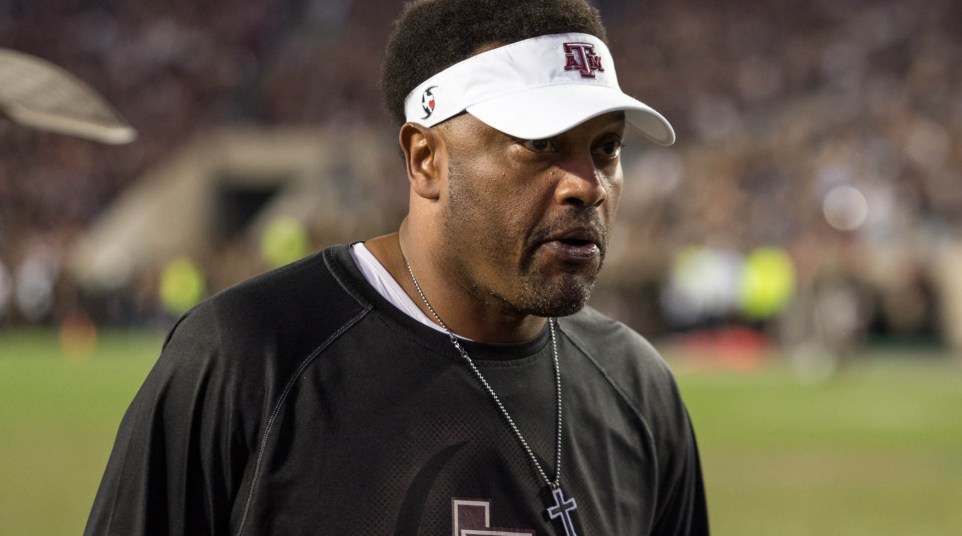
Kevin Sumlin couldn't reach the high bar he set for himself, and that ultimately cost him his job
Perception and timing are everything in life. The same is true for college football coaches.
There are certain programs that will offer lifetime contracts to coaches who win 8 games per year. Look at guys like Dan Mullen and Kirk Ferentz. Can you picture the statues for Derek Mason or Mark Stoops if they led their programs to a handful of 8-win seasons?
Kevin Sumlin didn’t fall into that category. Well, perhaps local sculptors were getting their rasps ready after that magical, Johnny Manziel-led first season in College Station. That 11-win campaign produced a Heisman Trophy winner, an Alabama victory and a Cotton Bowl win against Oklahoma.
Sumlin, of course, never produced a season that came anywhere close to that first year. He never beat Alabama again (he also went winless against LSU), he never earned double-digit wins, he never finished with another winning record in SEC play and he ultimately never finished better than 4th in the SEC West.
Each year, Sumlin found a new way not to accomplish those feats. His 13-11 record in November had a lot to do with that. That also had a lot to do with his firing Sunday.
RELATED: Jimbo Fisher tops Aggies’ wish list
On the whole, it’s easy to look at Sumlin’s accomplishments (a 51-26 record with 3 bowl victories and only one losing record in the nation’s toughest division) and question if the Aggies had too high of expectations for their own good. Sumlin had a whole lot more success than the majority of Power 5 programs the past 6 years.
But perception and timing were everything for him.

Credit: John Glaser-USA TODAY Sports
A lot of people will come out and say how bad they feel for Sumlin, and understandably so. He’s a proven winner who handled himself well amidst some atypical circumstances. Between heat from his own athletic director and racist hate mail, Sumlin wasn’t exactly working under an all-hands-on-deck environment.
Of course, many would argue that those are the unfortunate side effects one has to deal with when he signs a guaranteed $30 million contract. That was signed after Sumlin won 9 games in his second season on the job. That was the last season that Sumlin finished ranked in the Associated Press top 25.
Speaking of the top 25, Sumlin’s time as a ranked team was telling:
- Games played as top-25 team before Oct. 31 — 32
- Games played as top-25 team after Oct. 31 — 16
The fact that Sumlin went 7-11 in SEC games in November didn’t help his cause. Four years in a row after the 2012 season, Texas A&M cracked the top 10 at some point during the regular season. In those 4 seasons, the Aggies finished in the top 25 just once.
This season was the first time that Sumlin failed to get the Aggies into the top 25 at all. A lot of that stemmed from that brutal start against UCLA. It was atypical for the Sumlin era. The jokes about Sumlin’s team getting their late-season collapse out of the way in the season opener were all over the Twitterverse.
But despite the wishes of a few too vocal higher-ups in College Station, Sumlin’s fate wasn’t sealed because of that game. For once, he actually lowered the bar for himself. His team rose above minimal expectations with a 3-1 start to SEC play, which produced a hard-fought loss to No. 1 Alabama.
Unfortunately for Sumlin, that game was the beginning of a 3-4 stretch to close the season.

Credit: Kim Klement-USA TODAY Sports
He was the most obvious hot seat candidate in America entering the season after what A&M athletic director Scott Woodward said about the Aggies “needing to improve” in 2017. After all, Sumlin had failed to improve on his previous win total in any given year in College Station. The natural perception was that he was trending in the wrong direction.
So what’s the moral of the story? Are coaches like Sumlin better off just tanking their first seasons? Of course not. This isn’t the NBA. The only way to avoid being perceived to be “trending in the wrong direction” is simply to improve. That, obviously, is way easier said than done. That’s why an AD can sit there and say that.
Sumlin will be coaching again. Perhaps he’ll do so at Arizona State, where reports are already linking him to the job after the program surprisingly fired Todd Graham. How fitting that would be considering Graham also fell victim to raising the bar too high for himself by averaging 9 wins in his first 3 seasons and averaging 6 wins in his final 3.
Whatever lies ahead for Sumlin, he’ll have a fresh perspective on what perception and timing means in the coaching business. He’ll know that in this era of college football — where 8-figure buyouts are becoming the norm (he’ll get $10 million) — there’s absolutely a bar that needs to be reached every year.
And more times than not, that’s nearly impossible.
